Different Waffle Types for Breakfast:
Start Your Day on the Right Foot
Our morning meal is known to be called “the most important meal of the day”. There are various waffle types to consider for breakfast or brunch, each with a unique blend of ingredients such as flour, eggs, sugar, milk, and butter. While waffles for breakfast are in general perceived as not necessarily healthy, we will try to guide you through how to turn this delicious treat into a healthy option.
Waffles are an irresistible and highly popular breakfast food enjoyed worldwide, especially in Belgium, where it’s a national dish with more than a dozen regional variations. They are prepared by placing the batter or dough between two hot plates or waffle irons, designed in a grid-like pattern, producing the trademark texture that we all recognize and love. The indentations on the waffles are called pockets and they hold the toppings.
Talking about toppings, a plethora of toppings, ranging from fresh fruits to whipped cream, syrups, chocolate, and ice cream, can accompany waffles. In some parts of the world, this treat can also be enjoyed as a savory dish, served with cheese, bacon, or other toppings. They can be prepared fresh or warmed up after being pre-cooked and frozen commercially.
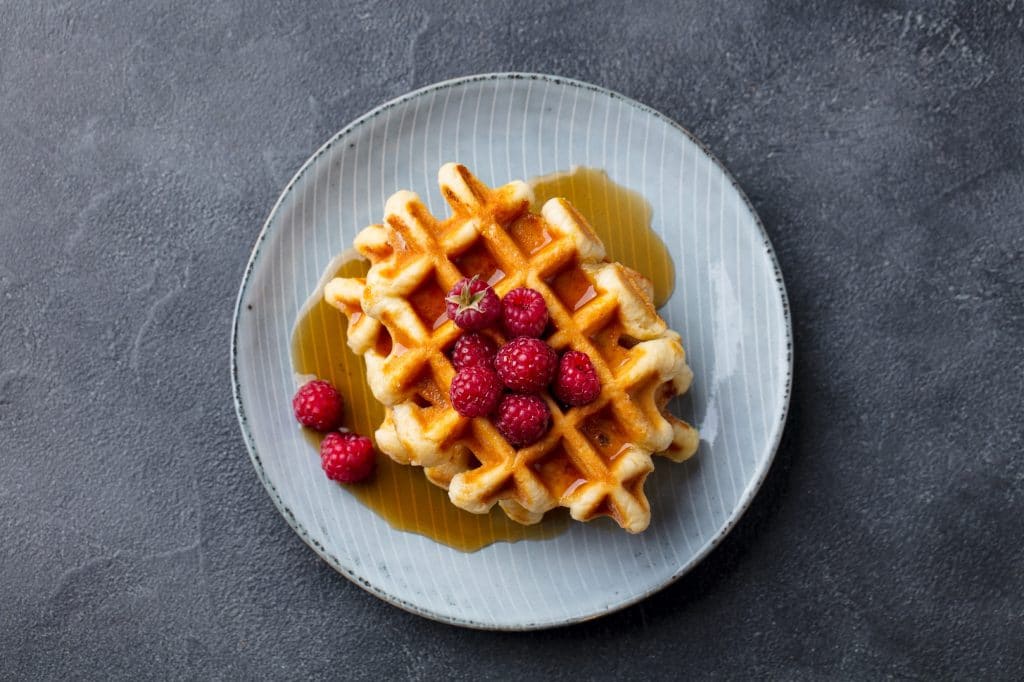
Different Waffle Types Around the World
Waffles come in a diverse range of types worldwide, each with its own unique ingredients, flavours, cooking techniques, textures and designs. Some are famous for their thickness, fluffiness and deep grid pattern, while others are known for their special shape or more sweetness in taste.
Here are some examples of popular ones from around the globe:
| Waffle Types | Image | Prepared with … | Taste | Shape | Origin |
| Belgian | 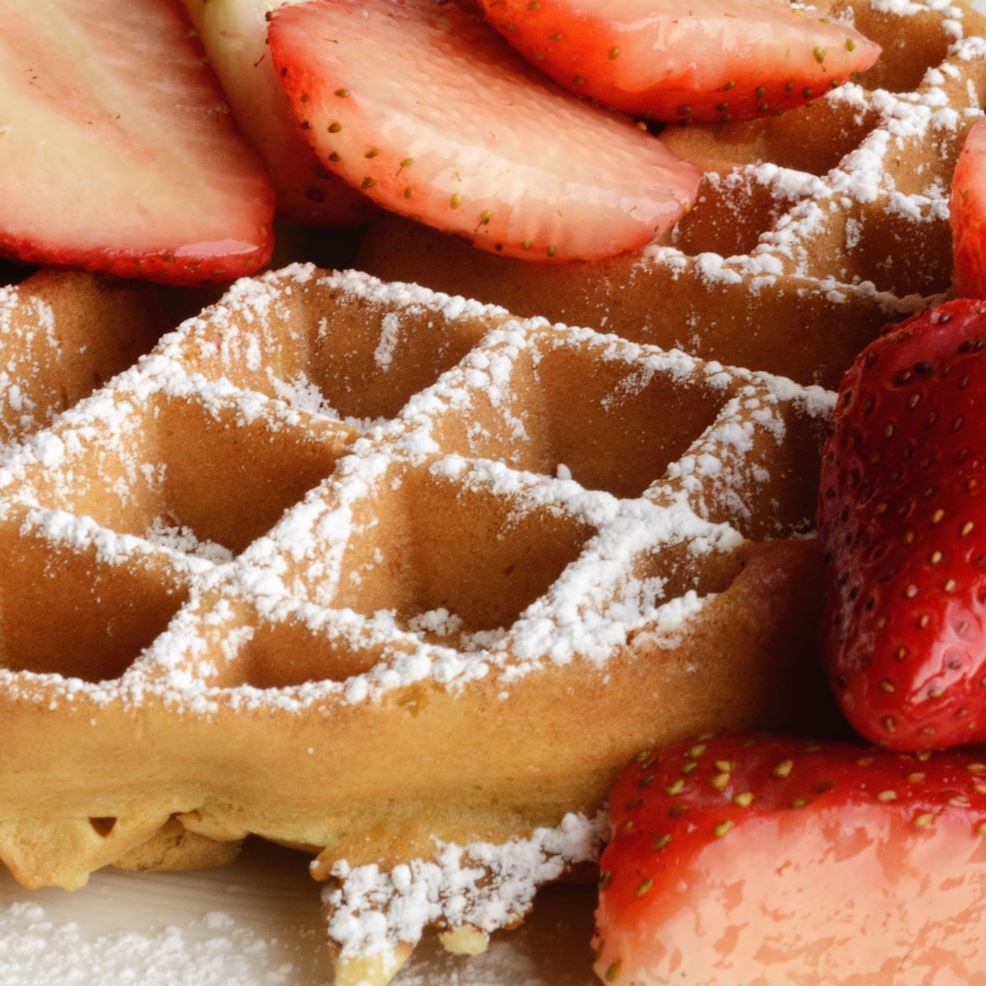 |
Baking soda leavened | Simplified version of the Brussels waffle | 1 ½” depth | North America |
| Brussels | 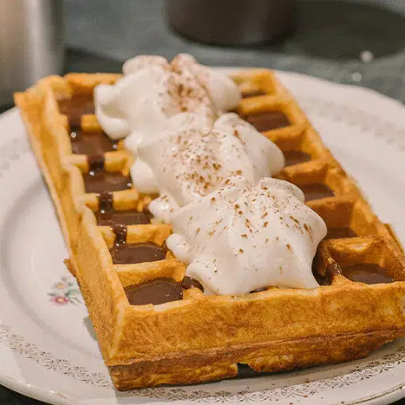 |
Egg-white-leavened or yeast-leavened batter | Light and crisp | Rectangular with large pockets | Belgium |
| Liège – Hunting waffles | 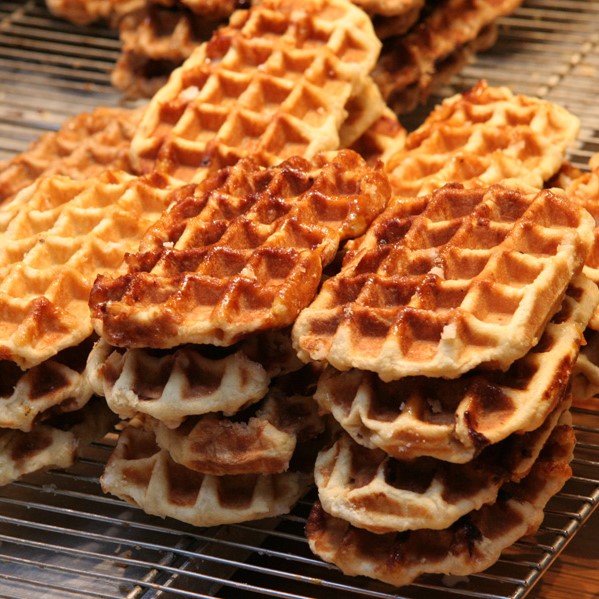 |
Brioche bread dough with chunks of pearl sugar caramelized on the outside | Rich, dense, sweet, and chewy | Sun-like shape | Wallonia region of Eastern Belgium |
| Flemish | 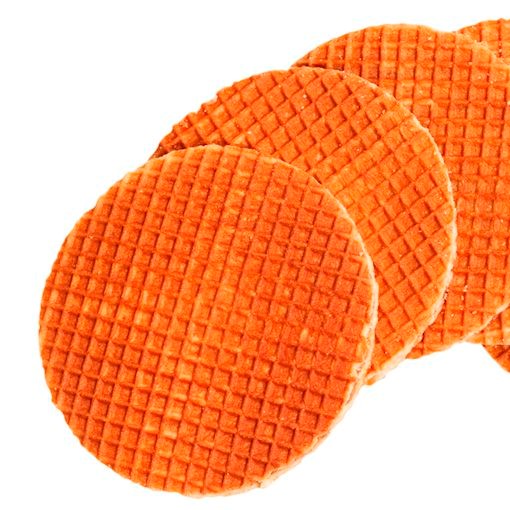 |
Brewer’s yeast barm and served with sugar and orange blossom | Thin and round | Northern France and portions of western Belgium | |
| American | 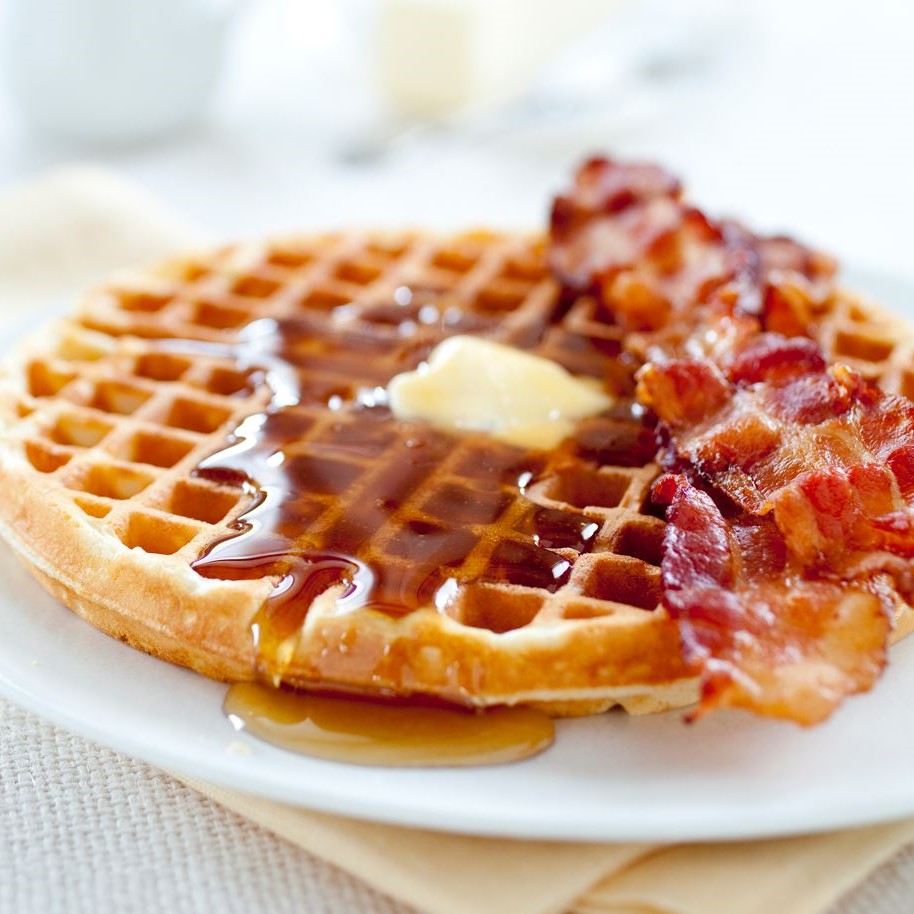 |
Topped with butter and maple syrup, bacon, and other fruit syrups, honey, or powdered sugar | Denser and thinner than the Belgian waffle | Round in shape and divided into 4 quarters | US |
| Bergische |  |
Served with cherries, cream and optionally rice pudding | Crisp and less dense than Belgian waffles | 4 Divided heart shaped | Germany (Berg county) |
| Hong Kong-style (also known as “grid cake” or “grid biscuits”) | 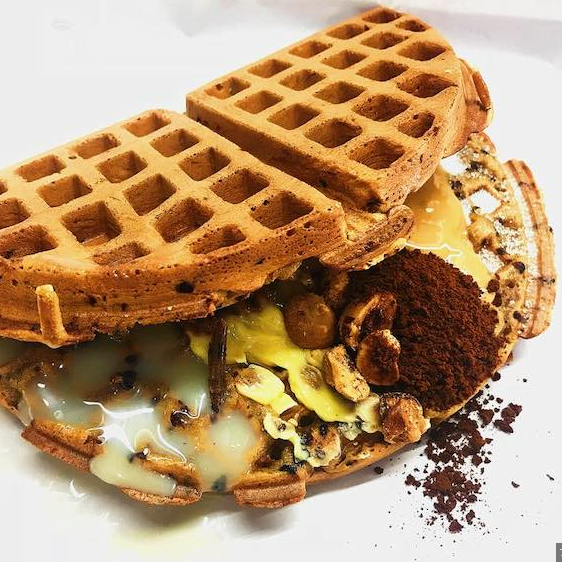 |
Eggs, sugar and evaporated milk. Butter, peanut butter and sugar inside | Soft, sweet and not yolk flavour | Round in shape and divided into 4 quarters. Served as semicircles | Hong Kong |
| Pandan | 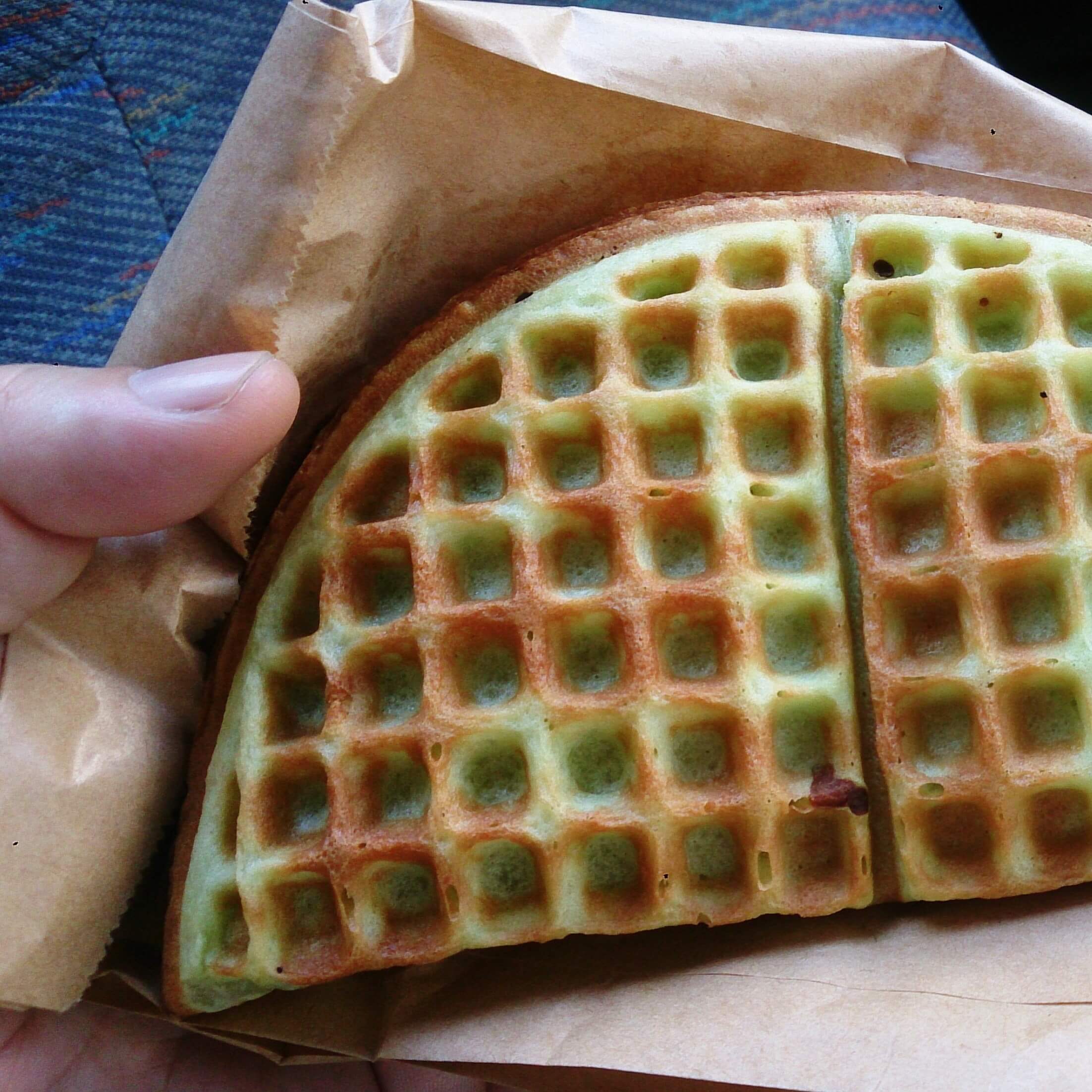 |
Pandan and coconut milk | Crispy outside and chewy inside | Green and eaten plain | Vietnam |
| Croffle |  |
Croissant raw dough baked in a waffle pan and eaten with ice cream or maple syrup | Chewy | Flattened croissant | Ireland |
| Kue gapit | 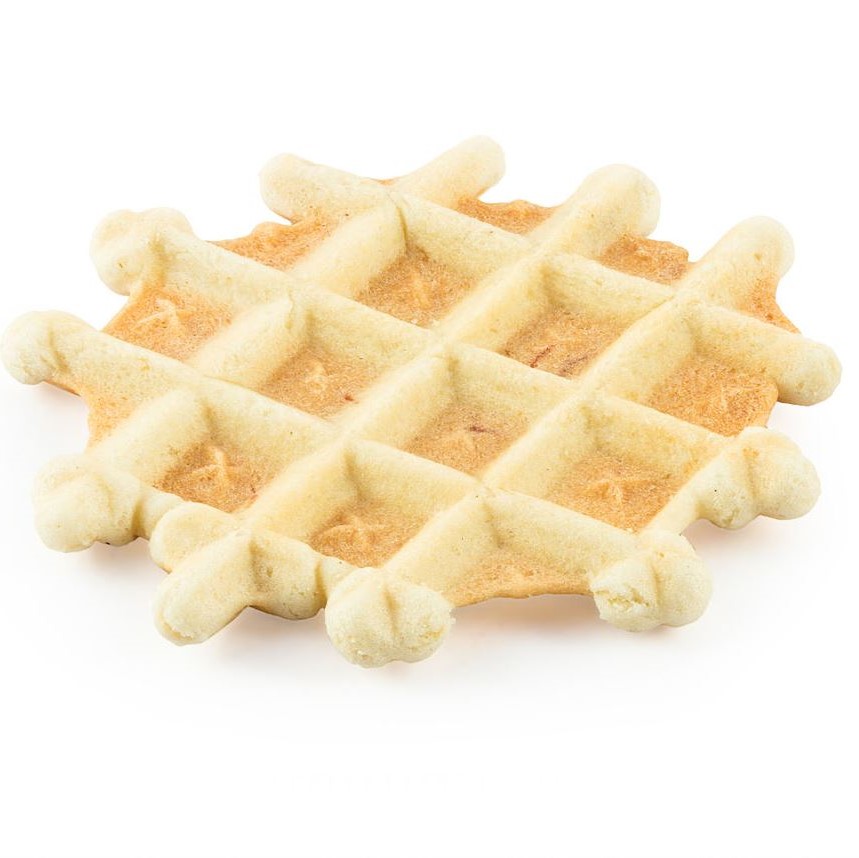 |
Tapioca flour and eggs | Dry snack | Thin crackers | Indonesia |
| Scandinavian | 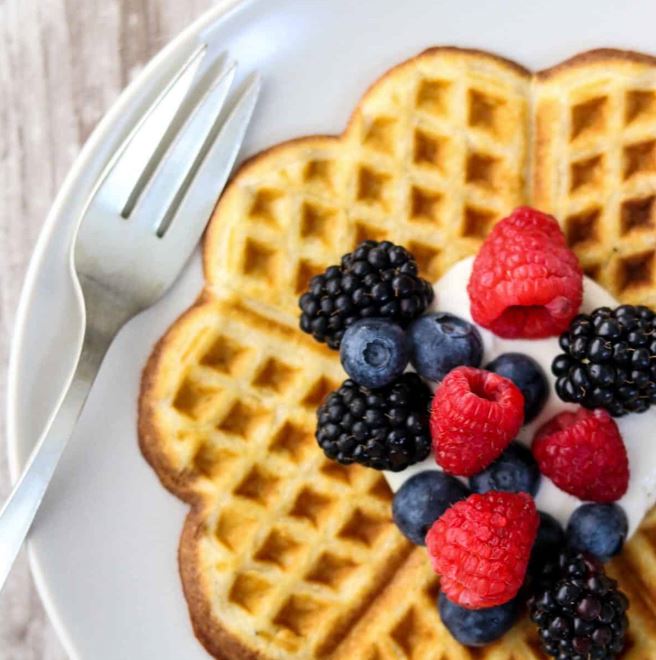 |
Made with cream. No sugar added. Topped mostly with sweet toppings (some countries offer a savory version as well) | Buttery and tender | Thin and round or heart-shaped | Finland, Iceland, Norway, Sweden |
| Gofri | 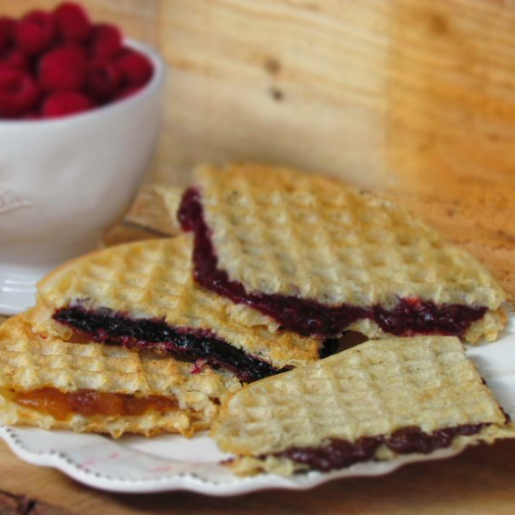 |
No egg or milk and come in sweet and savory versions | Light and crispy | Pressed sandwich-like | Italy (Northwest) |
| Stroopwafel | 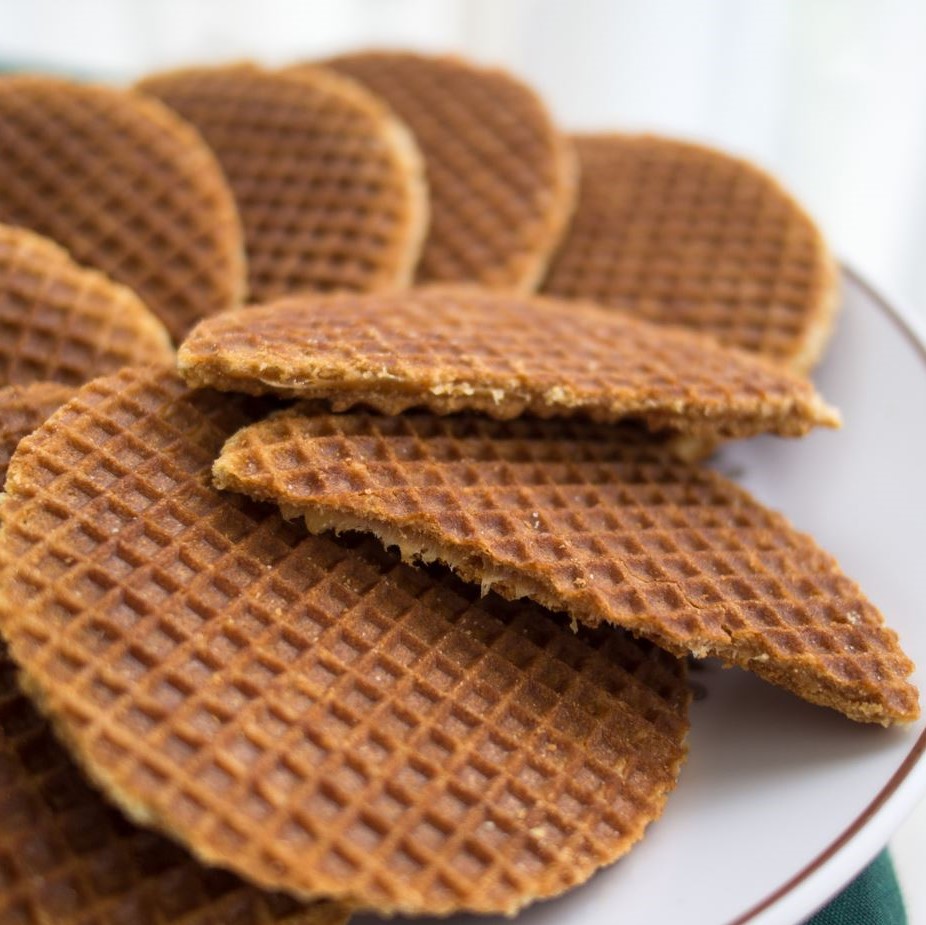 |
Flour, butter, brown sugar, yeast, milk, and eggs | Thin with syrup filling | Round shape that is cut into halves | Netherland (Gouda) |
| Galettes Campinoises (Kempense galetten) | 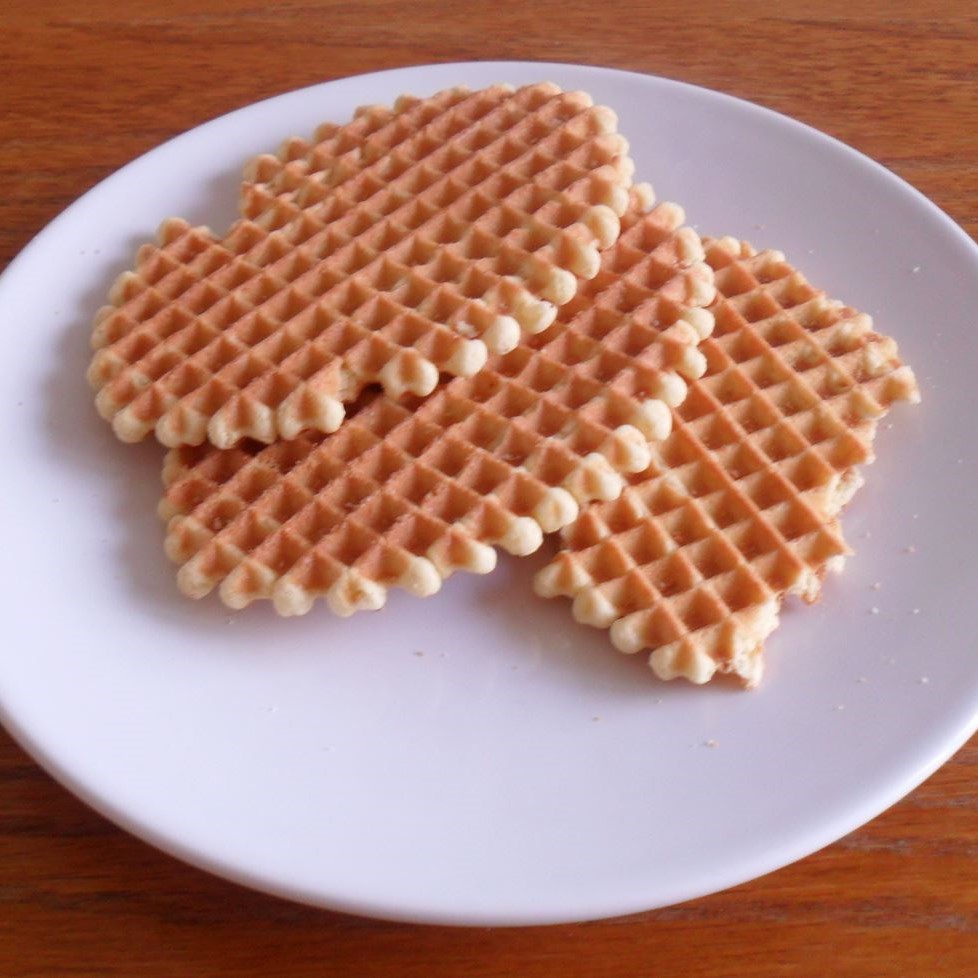 |
Flour, butter, brown sugar, vanilla, and eggs | Rigid and crunchy, but are buttery, crumbly and soft | Large cookie-like | Belgium (Northeast) |
| Hotdog | 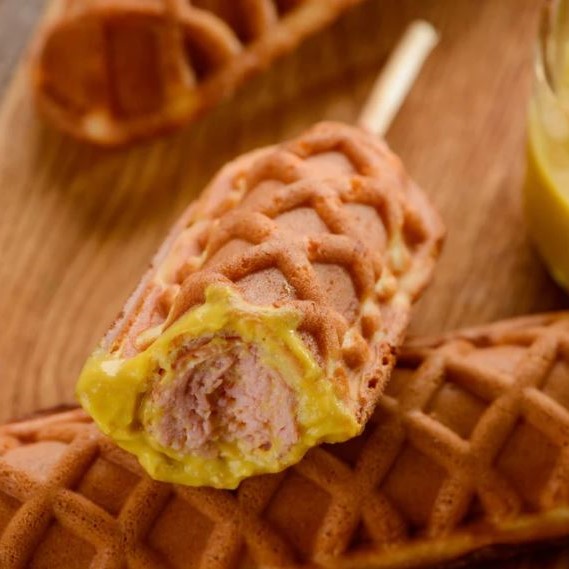 |
Hotdog inside | Cylindrical shape | Hawaii, Philippines | |
| Rolled-up waffle ice cream cone |  |
Ice cream inside | Thin and crusty | Cone-shape | Around the world |
| Waffle Types | Image | Prepared with ... | Taste | Shape | Origin |
|---|---|---|---|---|---|
| Belgian |

|
Baking soda leavened | Simplified version of the Brussels waffle | 1 ½" depth | North America |
| Brussels |

|
Egg-white-leavened or yeast-leavened batter | Light and crisp | Rectangular with large pockets | Belgium |
| Liège - Hunting waffles |

|
Brioche bread dough with chunks of pearl sugar caramelized on the outside | Rich, dense, sweet, and chewy | Sun-like shape | Wallonia region of Eastern Belgium |
| Flemish |

|
Brewer's yeast barm and served with sugar and orange blossom | Thin and round | Northern France and portions of western Belgium | |
| American |

|
Topped with butter and maple syrup, bacon, and other fruit syrups, honey, or powdered sugar | Denser and thinner than the Belgian waffle | Round in shape and divided into 4 quarters | US |
| Bergische |

|
Served with cherries, cream and optionally rice pudding | Crisp and less dense than Belgian waffles | 4 Divided heart shaped | Germany (Berg county) |
| Hong Kong-style (also known as "grid cake" or "grid biscuits") |

|
Eggs, sugar and evaporated milk. Butter, peanut butter and sugar inside | Soft, sweet and not yolk flavour | Round in shape and divided into 4 quarters. Served as semicircles | Hong Kong |
| Pandan |

|
Pandan and coconut milk | Crispy outside and chewy inside | Green and eaten plain | Vietnam |
| Croffle |

|
Croissant raw dough baked in a waffle pan and eaten with ice cream or maple syrup | Chewy | Flattened croissant | Ireland |
| Kue gapit |

|
Tapioca flour and eggs | Dry snack | Thin crackers | Indonesia |
| Scandinavian |

|
Made with cream. No sugar added. Topped mostly with sweet toppings (some countries offer a savory version as well) | Buttery and tender | Thin and round or heart-shaped | Finland, Iceland, Norway, Sweden |
| Gofri |

|
No egg or milk and come in sweet and savory versions | Light and crispy | Pressed sandwich-like | Italy (Northwest) |
| Stroopwafel |

|
Flour, butter, brown sugar, yeast, milk, and eggs | Thin with syrup filling | Round shape that is cut into halves | Netherland (Gouda) |
| Galettes Campinoises (Kempense galetten) |

|
Flour, butter, brown sugar, vanilla, and eggs | Rigid and crunchy, but are buttery, crumbly and soft | Large cookie-like | Belgium (Northeast) |
| Hotdog |

|
Hotdog inside | Cylindrical shape | Hawaii, Philippines | |
| Rolled-up waffle ice cream cone |

|
Ice cream inside | Thin and crusty | Cone-shape | Around the world |
For more interesting facts about the above waffle types, read more below:
-
Belgian:
Belgian waffles are believed to take their name from the Bel-Gem brand, which was promoted by vendor Maurice Vermersch, who came from Brussels, Belgium. The thicker style was also popularized at the 1964 New York World’s Fair.
-
Brussels:
The oldest recognized reference to Brussels waffles by name (Gaufres de Bruxelles) is attributed from 1842/43 to a Swiss baker named Florian Dacher in Ghent, Belgium, who worked in central Brussels.
-
Liege:
This type of waffle is recognized as a high-quality version that even cold and without toppings will satisfy your taste buds. In the US, Liege waffles are best known for being sold at ski resorts, mostly in the Northeast, under the “Waffle Cabin” brand.
-
Flemish:
The original recipe for Flemish waffles was published in 1740 by Louis-Auguste de Bourbon in Le Cuisinier Gascon.
-
American:
Waffle House, which is a large chain of waffle specialty diners, has over 1,900 locations across the U.S., especially in the south where the chain is considered a regional cultural icon.
-
Bergische:
Bergische waffles are served as part of the traditional afternoon feast on Sundays in this German region.
-
Hong Kong style:
Hong Kong style ones are usually served as street food or snack in various colours. The more traditional ones are full of yolk flavour, but sometimes different flavours such as chocolate and honey melon are also used in the recipe.
Hong Kong has another popular variant called “Bubble Waffle” or “Hong Kong egg puff”, with similar ingredients but in the shape of a bubbly cone.
-
Pandan:
Pandan waffles are relatively cheap and especially popular among children In Vietnam. They are made using either electric waffle makers or cast iron molds heated with charcoal.
-
Croffle:
Croffle (a combination of croissant and waffle) originated from a cafe called “Le Petit Parisian” in Dublin, Ireland, where a baker named Louise Lenox first introduced it as a menu item.
-
Kue gapit:
Kue gapit originates from West Java’s city of Cirebon. It’s a popular souvenir among visitors to Cirebon, however, it is rarely consumed by the region’s residents. The name “gapit” is derived from the cooking method, which involves sandwiching the kue between iron molds, a process known as “mengapit” in Indonesian.
-
Stroopwafels:
Stroopwafels originated from the Dutch city of Gouda. They are a popular snack in the Netherlands and Belgium, where various waffle types can be easily found in pre-packaged containers at local shops and markets.
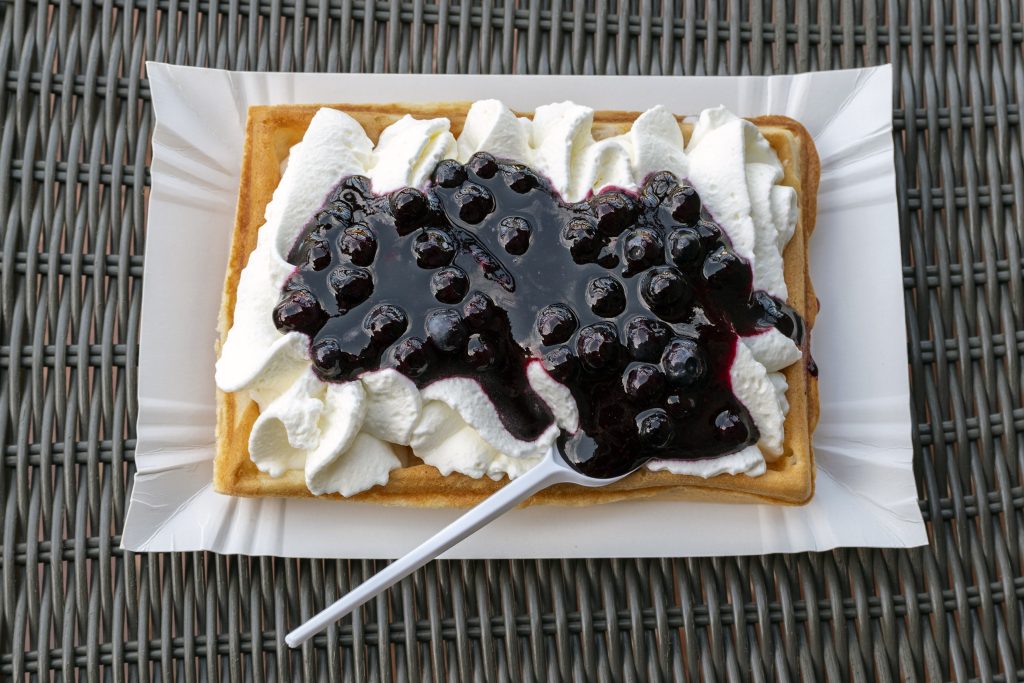
Hot waffle topped with whipped cream and blueberries
Are Waffles a Healthy Food?
The common waffle is usually made with ingredients that nutritionists suggest limiting the consumption of, such as white flour, butter, and sugar. Eating large portions or adding unhealthy toppings such as excess whipped cream, syrup, or butter can make eating waffles even a less healthy option for breakfast.
Additionally, many commercial brands are heavily processed and contain excessive amounts of added sugar and unhealthy fats that can have a negative impact on your well-being in the long term.
These popular treats are surely delectable, but whether or not they’re a healthy choice for breakfast, depends on various factors such as the ingredients used, the serving size, and personal dietary needs and preferences.
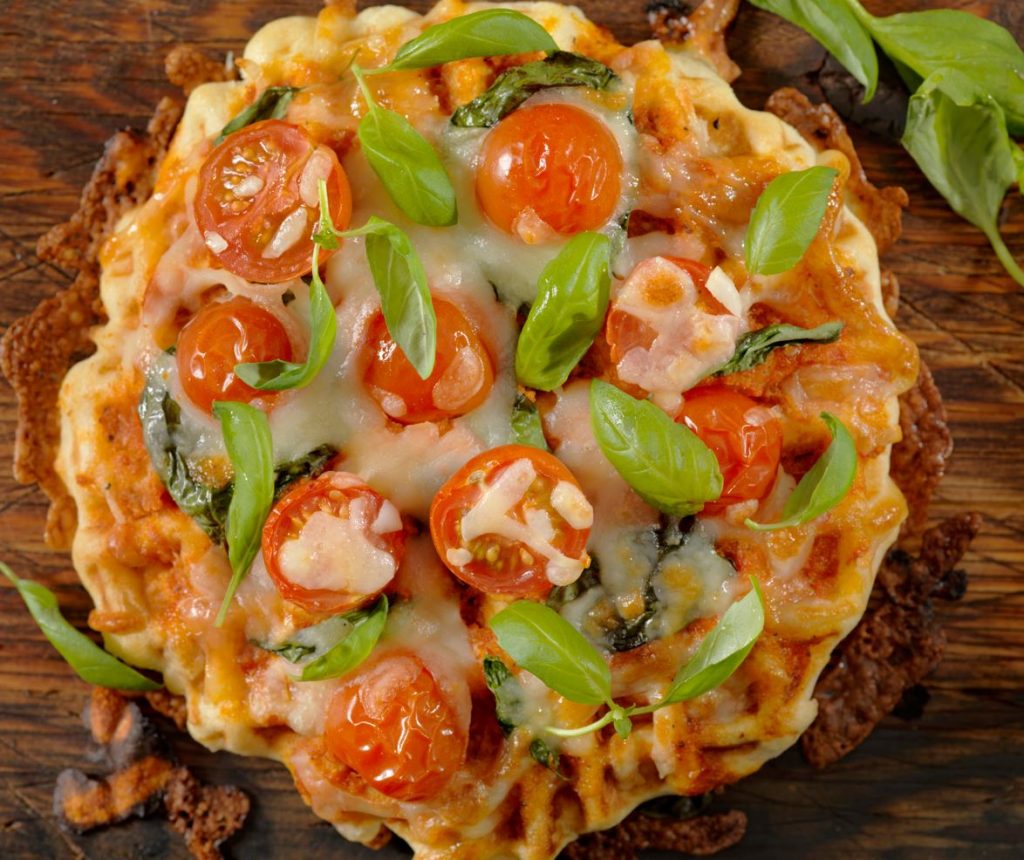
Savory waffle Margharita-style
How to Make a Healthy Waffle for Breakfast?
By implementing a few simple tweaks, you can transform waffles from a calorie and sugar bomb into a nutritious and gratifying breakfast option.
-
Using whole-wheat flour:
Selecting white whole-wheat flour over white flour is a wise decision to avoid empty calories (When a food does not contain nutrients or if the calories from sugar and fats outweigh the nutrients, it’s considered to be a source of empty calories). This way, you can receive extra fibre and the whole grains will satisfy your craving.
-
Using healthier oils:
For example, you can have the perfect crispy outer shell and soft interior by using coconut oil. Coconut oil behaves just like vegetable oil but is considered to be healthier.
-
Going easy on sugar:
Many recipes call for a lot of sugar, but you can reduce the amount without too much affecting the taste. Start by cutting as much sugar as you can and try adding a little bit of real maple instead, if you need more sweetness.
-
Choose healthier toppings:
Instead of using syrup or whipped cream as topping, try adding a handful of fresh fruits such as blueberries, strawberries, or banana slices. This will add extra fibre, nutrients and antioxidants.
-
Adding protein:
Adding ingredients like Greek yogurt, nuts, or protein powder, is an excellent way to incorporate protein into your diet.
-
Serve smaller portions:
After all, eating smaller portions is another easy way to cut back on sugar and fat. Instead of making large waffles, try making mini ones or cutting a regular one into smaller pieces.
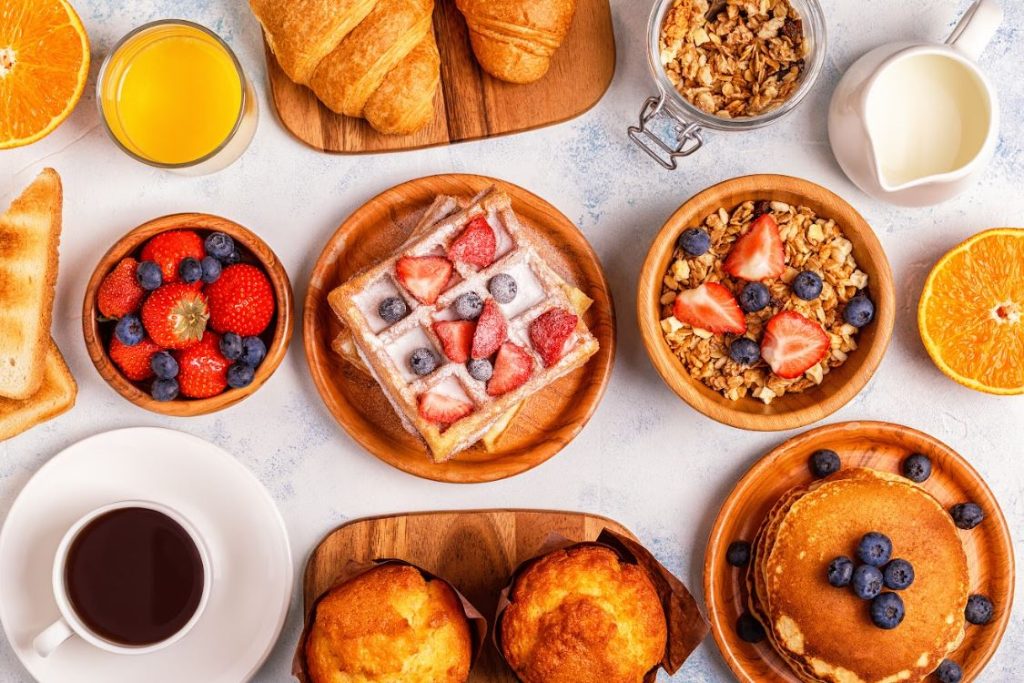
Breakfast table with waffles, granola, pastries and pancakes
Is Breakfast the Most Important Meal of the Day?
The idea that breakfast is THE most important meal of the day is a widely held belief, however, there is considerable debate around its validity.
“While it seems breakfast is the most important meal of the day, it might actually be dinner,” says Courtney Peterson, an internationally recognized researcher in the field of intermittent fasting in a BBC article. “Our blood sugar control is best early in the day. When we eat dinner late, that’s when we’re most vulnerable because our blood sugar is worst. There’s more research to do, but I’m confident you shouldn’t skip breakfast and have dinner late.”
At the end of the day, there’s no conclusive evidence on exactly what we should be eating and when. But everyone seems to agree that we should listen to our own bodies and eat when we’re hungry.
Perhaps it’s best to avoid assigning excessive significance to any particular meal, but rather examine our eating habits throughout the day. Breakfast is not the only meal we should be getting right.
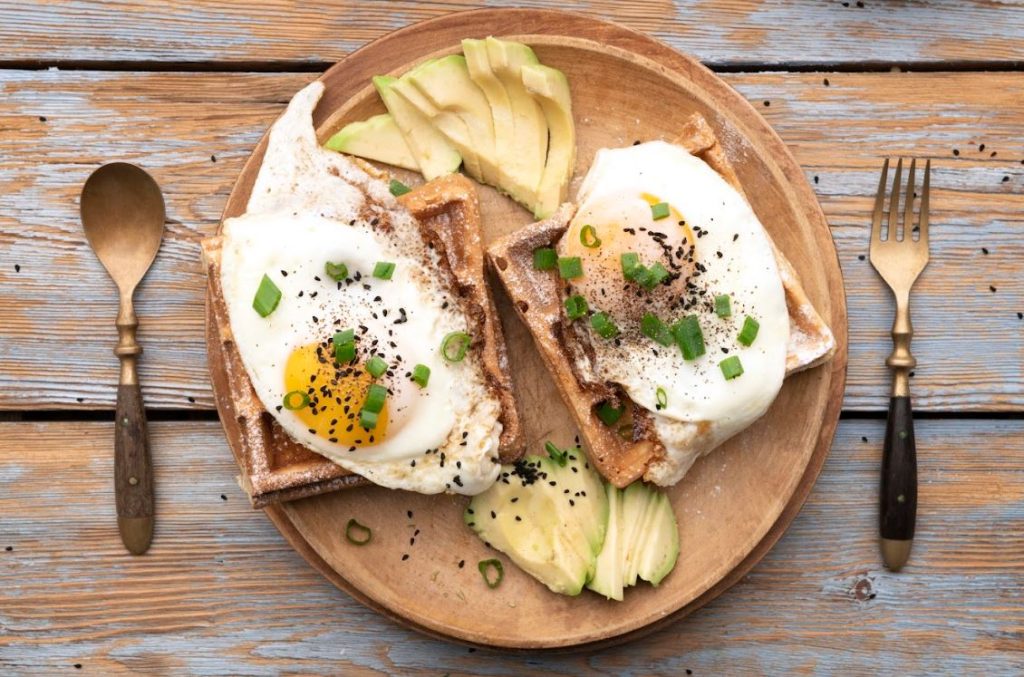
Healthy savory waffle for breakfast
Why Does a Healthy Breakfast Matter?
While breakfast may not be the most important meal, it is still an important one, as it provides the body with energy and essential nutrients to start the day.
Having a nutritious breakfast can help:
- jumpstart metabolism,
- reduce food cravings later in the day, and
- improve cognitive function, concentration, and mood.
In general, a healthy breakfast should be balanced and provide essential nutrients to fuel the body for the day. Whole grains, protein, fruits or vegetables, healthy fats, and hydration are among the main components of a healthy breakfast. These benefits can lead to increased productivity and better overall health, especially for children and teenagers.
That’s why organizations such as Breakfast Club Canada work with partners across all sectors to roll out a quality national school feeding program. Their programs reach more than 580,000 children in more than 3,500 schools across Canada every day. The World Food Programme, considers breakfast programs to be an effective way of supporting the education and development of children. These programs are child-focused, but their positive impact trickles down to families, schools, and communities.
Although breakfast might not be the most important meal of the day, it still holds much significance as it supplies the body with crucial nutrients and energy to initiate the day. Different waffle types with various ingredients and cooking styles can be a delicious and healthy option for breakfast, if prepared mindfully. So, next time you’re craving something tasty and healthy, consider making a waffle for breakfast and explore the endless possibilities of this beloved treat.




